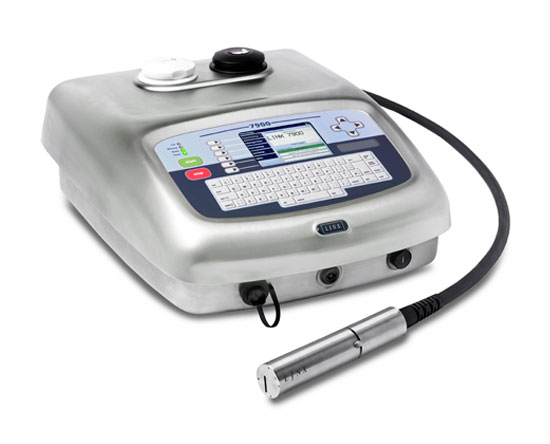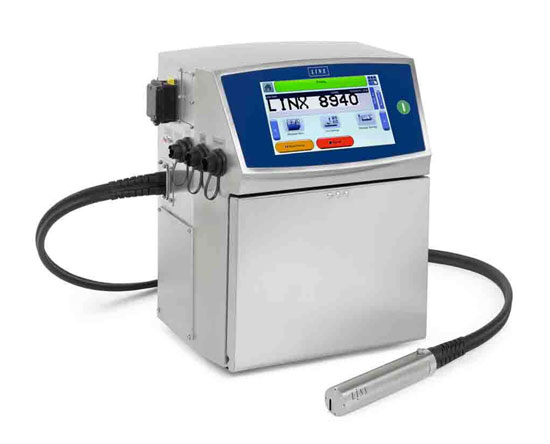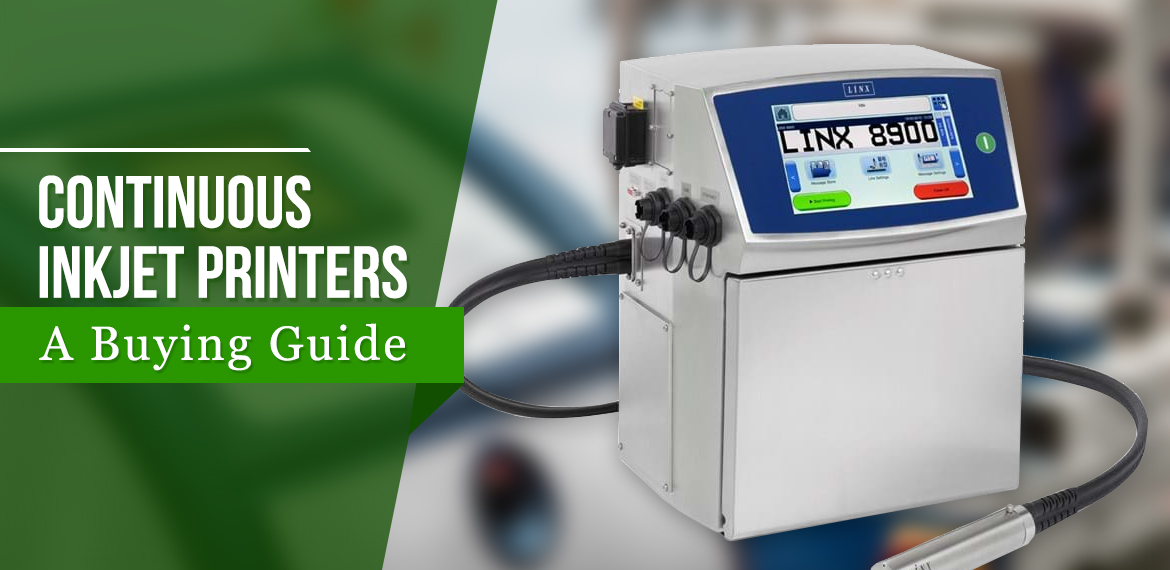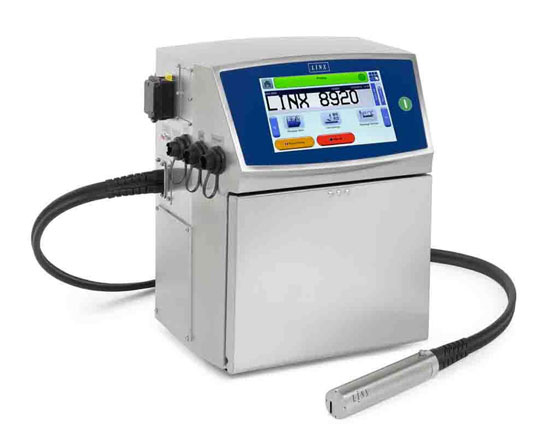If your business deals with large quantities of goods, you’ll probably need a reliable printer for labels, serial numbers, expiry dates, and other important information. You can’t settle for just any printer, however. Whatever your machine prints should be readable and long-lasting on your products. At the same time, coding and marking on your assembly line ought to be as fast as possible. Cost-efficiency is also a valuable plus that can help contribute to company growth. With these requirements in mind, continuous inkjet printing might be the technology that your business needs.
Your continuous inkjet printer of choice will remain on your assembly line for a while, so you’ll want to invest in a machine that matches your particular application and that won’t cause inconveniences in the long run. Here’s a continuous inkjet printer buying guide that you might find helpful.
How Continuous Inkjet Printers Work
Continuous inkjet printing is a popular coding and marking option for countless companies nowadays. A non-contact coding process and a wide range of available ink allow CIJs to print onto various substrates.
During operation, CIJs expel electrically charged droplets of ink from a printhead nozzle. A piezoelectric crystal breaks the initial ink jet into drops. Then, an electrode charges the drops which are required for printing while the other drops are recirculated into the ink stream. The selected droplets then pass through an electrostatic field. Together with the droplets’ speed, the charge from the electrode determines where the codes and marks will be printed on the substrate. CIJs often expel up to 120,000 charged droplets a second.
All of this occurs without the printer directly touching the substrate, eliminating any risk of damage to the printing surface. This automatically gives CIJ printers an advantage over contact coders. Also, because CIJ machines use external ink tanks instead of traditional cartridges, these industrial printers are capable of putting out thousands of pages before needing refills, and they do not produce waste from cartridge replacements. This renders them cost-effective and even eco-friendly.
On top of that, the ink for CIJ printers is available in numerous colors and contrasts. Machines that fall under this type can print onto irregular products and produce readable marks on high-speed lines.
To give you an idea of just how flexible these machines are, here are a few examples of what CIJ coders can print:
- Date codes on the bottoms of glass bottles and on the insides of bottle caps
- Serial numbers on wooden panels and metal sheets
- Text on printed circuit boards
- Expiry dates on the foil packaging of tablets and pills
- Wattage information and model number on the side of a lightbulb
- Wire size and type along the length of a cable
- Barcodes and serial numbers on car parts
- Specifications and manufacturer logos on plastic piping
No matter what you’ll be coding, you can maximize the advantages of a continuous inkjet printer by making an informed and well-planned purchase. This includes asking the right questions and taking your exact business needs into consideration. Here are 10 guide questions for when you start looking for your company’s new continuous inkjet printer.
9 Important Questions to Ask When Buying a Continuous Inkjet Printer
1. How Reliable is the Printer?
This is more than a matter of your machine’s lifespan. You’ll need to look up the printer’s average mean time between failures (MTBF), which is often among the device specifications, although your supplier should be able to cite it as well. Then, calculate reliability, or R(t):
R(t) = e-λt
where λ is the inverse of your MTBF (i.e. 1/MTBF). With this formula, you can determine the probability that your printer will fail within a given amount of time.
Other similar factors are the mean time between maintenance (MTBM) and the mean pages before failure (MPBF).
2. How Fast Will You Be Printing?
Buyers often check printers’ line speeds before anything else. The line speed determines whether your continuous inkjet printer will be fast enough to keep up with production demands. Do allow some room and choose a printer that is slightly faster than what your assembly line actually needs, to account for increases or spikes in demand.
3. Does it Use the Right Ink for Your Job?
Each substrate has a matching ink type, whether specified by the manufacturer or suggested by your supplier. Make sure that your printer will actually be able to print on your products! You may estimate how much you’ll be spending on ink and try to look for more cost-effective alternatives. Also, feel free to ask your suppliers about refills! They can point you to the best ink manufacturers, if they’re not distributing the ink themselves.
4. Where Will You Use the Equipment?
Unlike portable home printers, industrial continuous inkjet printers are large machines that take up a lot of space and need additional room for operators. A few of them even give off volatile fumes during operation. Plan well if you’ll be using your new printer alongside other coding and marking machines, and take time to find a device that will fit well into your assembly line setup.
Will your printer be exposed to moisture or dust? Make some room in your budget for some IP65 rated protection to keep your printer in top shape. Choose casing that offers added safety from falling objects and other impacts.
5. What Size Will Your Printed Marks Be?
Another key specification is the printer’s line height. Characters can be as small as 0.6mm (e.g. anti-counterfeiting methods) or as big as 20mm (e.g. information on cartons). Are you looking for a machine that can print both, however? Try inquiring about continuous inkjet printers with a wide range of line heights. This can help you avoid having to spend on multiple coders.
6. How Complex are Your Printing Needs?
You’ll most likely be able to find an affordable printer that can print two or three lines of text. Some inkjet coders can store up to 1,000 messages and print across four production lines. The right printer won’t just cover most of your coding requirements, but it will also be scalable to some extent, in case your company introduces new products with different sets of codes.
7. Who Will Operate and Maintain the Printer?
Employees will certainly need to learn how to use your new continuous inkjet printer properly. Do find out if the training is included as part of the purchase and whether it will be online, over the phone, or in person. It’s also never too early to ask about other post-sales services such as maintenance. A topnotch supplier with a good history can gladly help you out with this.
8. What About Warranties and Repairs?
Many print-heads and other important printer parts can’t actually be repaired, but need to be replaced instead. Printers with more complicated designs (i.e. more potentially irreparable parts) might have higher chances of failure, so to be safe, you might want to opt for a continuous inkjet printer which has a streamlined, durable design centered on ease of use.
New printers usually have warranties. However, costs and exact coverage will differ between machines. Be sure to find a good warranty length and understand its terms clearly!
9. Does the Printer Fit Into Your Budget?
This might sound like an obvious question, but you’ll be surprised at how much a special feature can increase the price of a new machine. Before going for a continuous inkjet printer that stretches your budget, ask yourself if extra speed or pricier ink will really pay off in the end.
ALSO READ: 5 Benefits of Including Collaborative Robots on Your Assembly Line
3 Continuous Inkjet Printers You May Want to Consider
Aside from knowing what questions to ask, it also helps if you have an idea of what brands to check out. For one, you might want to consider the world-class manufacturer Linx and its lineup of continuous inkjet printers. Linx products are renowned for being reliable, easy to use, and cost-effective. Its CIJ printers in particular feature sealed print heads with a time-saving auto-flush function. With an IP55 rating, they are dustproof and waterproof, and they can function without factory air.
Here are 3 Linx CIJ printers you might want to consider for your next purchase. One of these machines may even turn out to be the perfect addition to your assembly line!
- Linx 7900

If you’re looking for a robust continuous inkjet printer for food-grade applications, ultraviolet security features, and other types of specialist coding, the Linx 7900 might be the coder for you.
This CIJ coder can print up to 5 lines of text at a time, aside from text, graphics, logos, and data matrix codes. An automatic printhead cleaning system ensures smooth, trouble-free startup, while the SureFill® system keeps refills quick and tidy.
It comes with a pre-installed Linx Insight® remote web interface, which allows you to monitor the status of your printer from your smartphone. Through this same interface, you can download or upload messages from your own PC as well! You also won’t have to manually log line output anymore, as the Linx 7900 will accomplish that task itself with accuracy. It only needs to be serviced every 18 months or 9000 hours.
- Linx 8910

Image source: Linx 8910
The Linx 8910 continuous inkjet printer can help increase the output of your production line with its reliability and efficiency. Able to print characters between 1.8mm to 20mm high, it can take care of most of your coding needs by itself, whether you’ll be printing symbols, numbers, or barcodes. It is capable of printing up to 3 lines of text at once and reaching a line speed of 6.25m/s. The Linx 8910 can also use prompts to make sure that the right date and text is added to the code, or use date freezing for batch printing. You can even adjust the spacing between printed characters for increased readability and better vision system recognition. This makes the Linx 8910 suitable for both primary and secondary packaging.
Because of the simplicity of its design, the Linx 8910 can operate well for up to two years between services, which you can even carry out by yourself! You can also monitor and control this printer remotely, thanks to the cloud-based Linx Printernet capability. Finally, the Linx 8910 comes with an IP55-rated stainless steel enclosure, although you can avail of a completely dustproof IP65 option.
- Linx 8940

Carrying an IP65 rating by default, the Linx 8940 continuous inkjet printer is designed for tough environments and the most challenging printing jobs. It shares many features with the 8910, such as adjustable character spacing and Linx Printernet integration. However, it can print 5 lines of code at once, reaching line speeds of up to 9.10m/s. A large touch screen interface streamlines the code creation process. This printer is also built with a self-servicing module, unique system monitoring, and fluid cartridges that simply click into place, all aiming to simplify maintenance and minimize downtime.
With this buying guide, you’ll be able to narrow down your choices to a handful of continuous inkjet printers that closely match your business needs. You might still want to consult the manufacturer or a trusted supplier before deciding on your purchase, though.
Elixir Industrial Equipment, Inc. has supplied its clients with world-class continuous inkjet printers and other coders for the past 25 years, including expert post-sales service in its commitment. We also provide local distribution for international brands, including UK-based printing specialist Linx and its lineup of reliable, user-friendly machines. This means that we have the experience and expertise to cater to your company’s coding and marking needs. Contact us today to find out more!
Visit our blog regularly for more informative articles about industrial equipment.



